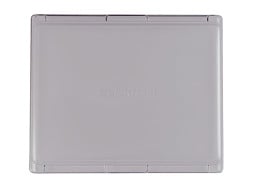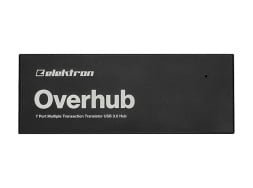Elektron Digitone
Gone are the days of antiquated FM synthesizers with impenetrable user interfaces, for Digtone, Elektron's compact eight-voice, four-track groovebox, rolls an accessible FM architecture, powerful sequencing, and abundant functionality into one compact instrument. Like the Digitakt II, the Digitone streamlines the experience of using an Elektron synthesizer into a more immediate package that still offers plenty of flexibility. Of course, there's also MIDI sequencing, Overbridge compatibility, and class-compliant USB audio interface functionality to ensure that Digitone fills multiple purposes in the studio or on stage.
Digitone's sound engine is based on a four-operator FM architecture, as popularized by some of Yamaha's post-DX7 instruments like the DX27, DX11, and TX81Zz. But with the ultimate aim of making FM sound design as approachable as possible, the Digitone consolidates things down into the most essential parameters, with visual feedback on the OLED screen to offer a representation of how the sound is being affected. The operators, which can be thought of as traditional oscillators combined with their own pitch and amplitude envelopes, may be re-arranged via eight different algorithms. These algorithms allow different ways for the operators to modulate each other, thus resulting in different flavors of FM. There are also parameters to define pitch ratios for each operator in relation to the note played by the sequencer or a keyboard, plus waveform morphing, detune, feedback, and a crossfade mix between separate audio paths denoted as X and Y.
Through reducing the intimidation factor of FM synthesis, Elektron borrowed filtering concepts from their past instruments for a unique blend of FM and subtractive synth stylings. Once sounds are generated in a traditional FM fashion, you have further sculptability through both a multimode filter with resonance and the classic Elektron Base-Width filter. There's also an ADSR-style envelope available for both the filter and amplitude, as well as two LFOs which may be assigned to modulate various sound parameters.
Each of the Digitone's tracks may be assigned to a different sound, and with the flexibility provided by its sound engine, there's a ton of room to cover nearly any type of sound imaginable. The eight voices of polyphony are shared across all tracks as needed, so you could easily lay down four-note pads on one track, and still have room for melodies, basses, or percussion on the other three. Digitone also adds a superpowered arpeggiator that can be activated independently for each track, plus support for chords, transposition, and more.
But like any Elektron product, Digitone comes alive with generous usage of its sequencer. At a basic level, each track offers up to 64 steps of sequencing, with independent settings for the number of steps and time scale in relation to the pattern tempo. From there, beloved Elektron features like parameter locks, micro-timing, and sound locks provide incredible levels of control by locking certain parameter values or even changing sounds entirely on a per-step basis. This is the secret to making the most out of the Digitone's polyphony limits, giving the illusion that you have more tracks than there actually are.
Speaking of the sequencer, there are also four MIDI tracks available to sequence your other gear. Between parameter locking CC values, polyphonic and chord sequencing, MIDI LFOs, and arpeggiator functionality, the Digitone has one of the most capable MIDI sequencers available on the market. Lean hard into the Digitone's capabilities as an FM groovebox and drum machine, but delegate pads and polyphony to an external synth for the best of both worlds.
Developed with the modern studio in mind, Digitone is capable of utilizing Elektron's Overbridge software suite. Simply connect Digitone to your computer via USB, and drop the VST or AU plugin into a track of your DAW to get instant access to every internal parameter of the Digitone's sound engine. Additionally, Overbridge allows you to stream each of the internal tracks (as well as the external inputs) to their own isolated tracks in your DAW, which is always appreciated when it comes time to mix. Beyond Overbridge, Digitone can also act as a class-compliant USB audio interface, making it a great companion for smartphones and tablets, or as an interface substitute for your laptop when traveling.
Few companies would be so bold as to flip the script on FM synthesis, but Elektron managed to do it with elegance. Digitone is a fresh take on FM packed with all the glassy sounds and shimmering textures you'd expect, but also provides a plethora of ways to shape and sculpt things as required by your music.
Digitone Features
Synth Voice
- 8 voice polyphony (multitimbral)
- Multiple FM algorithms
- 1 × multimode filter per voice
- 1 × base-width filter per voice
- 1 × overdrive per voice
- 2 × assignable LFO per voice
Sequencer
- 4 synth tracks
- 4 MIDI tracks
- 1 arpeggiator per track
- Polyphonic sequencing
- Individual track lengths
- Parameter locks
- Micro timing
- Trig conditions
- Sound per step change
Send & Master Effects
- Panoramic Chorus send effect
- Saturator Delay send effect
- Supervoid Reverb send effect
- Overdrive master effect
Hardware
- 128 × 64 pixel OLED screen
- 2 × 1/4” impedance balanced audio out jacks
- 2 × 1/4” audio in jacks
- 1 × 1/4” stereo headphone jack
- 48 kHz, 24-bit D/A and A/D converters
- Hi-Speed USB 2.0 port
- MIDI In/Out/Thru with DIN Sync out
Physical specification
- Sturdy steel casing
- Dimensions: W 215 × D 176 × H 63 mm (8.5” × 6.9” × 2.5”) (including knobs and feet)
- Weight: approximately 1.49 kg (3.3 lbs)
- 100 × 100 mm VESA mounting holes. Use M4 screws with a max length of 7 mm
Miscellaneous
- Overbridge enabled
- 3 year Elektron warranty
Included in the box
- Power Supply PSU-3b
- Elektron USB cable




Welcome Back!
Not a member yet?
You're in!
Join the Club!
As a member, get...
You're in the Club!